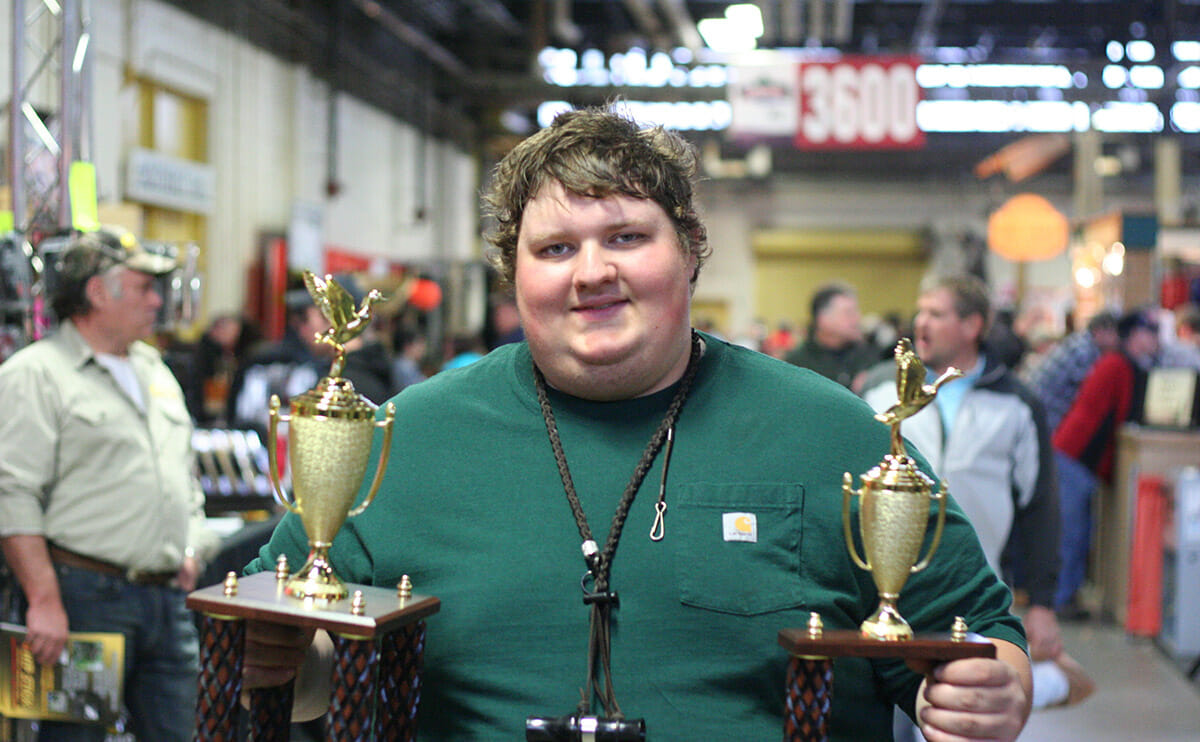At the Great American Outdoor Show, the best duck and geese callers face off to see who the top caller is.

The Real Thang is a woodwind, a single-reed. Some teenagers take up the clarinet. Matherly has spent countless hours practicing his goose call.
Next in his routine comes the “greeting and feeding” sequence to entice interested geese closer yet, followed by a “come-back,” a pleading, heartbroken wail used to coax a spooked goose back for a second try. Finally, there’s the landing call, a gentle coda to the performance, a series of welcoming honks to guide the goose down on its landing approach.
Some teenagers take up the clarinet. Bo Matherly has spent countless hours practicing his goose call.
In the field, callers’ success or failure could be determined by whether their performances lead an actual goose down into easy gunshot range. Here at the goose-calling contest at the Great American Outdoor Show, a massive event, Matherly and the other contestants are judged on the authenticity, tone and real-ness of their calls.
“It isn’t easy,” said Matherly, of Cecil County on Maryland’s Eastern Shore. “But once you start to learn the basics, it starts to come naturally.”
Matherly’s performance was convincing enough for first place and a $300 prize he plans to invest in decoys.
Where goose- and duck-calling differs from a more conventional instrumental recital is that all the performers are playing the same song. All the Canada Goose-calling contestants gave the same four-part sequence of calls; each entrant in the Mallard-calling contest performed the same four-part Mallard sonata.
There is nuance. Geese’s calls are a little more freewheeling, giving the goose caller a bit more material to explore during the course of a routine. Mallard calling is more like haiku ”“ narrower, more prescribed, more exact.
Still, there is nuance, said Tom Bryce, winner of the Mallard contest and the runner-up goose caller. Geese’s calls are a little more freewheeling, giving the competitive goose caller a bit more material to explore during the course of a routine (or an actual hunt). Mallard calling is more like haiku ”“ narrower, more prescribed, more exact.
The giant showroom devoted to game calls ”“ a small part of the Great American Outdoor Show ”“ rattles with a cacophony of hoots, honks, gobbles and other calls being demonstrated and tested. Bryce, 21, from Queen Anne’s County, a bit farther down Maryland’s Eastern Shore, has been hunting waterfowl for years. He spends two months every fall guiding duck hunts in Saskatchewan and much of his time from November to January as a goose-hunting guide in Maryland (he earns his living in heavy industrial construction in Baltimore the rest of the year). The duck-call he played to his first place finish was a J.J. Lares; his goose call is a Mitch Hughes.
As the callers file out after the event, contest organizer Bob Davis described calling game as “an integral part of hunting” ”“ something that people have been doing as long as they’ve been out hunting. And like pretty much any human endeavor, a small group of those people get really, really good at it and take it to competitive extremes. All the callers at the Great American Outdoors Show, Davis said, can so perfectly imitate wild birds that very few people could distinguish the goose caller from the goose.
The near-perfect authenticity of the duck- and goose-callers’ performances owes much to the march of technological progress. On the noisy game call showroom floor, Jeff Foiles of Foiles Migrators twists apart one of his calls to show off the “tone board,” against which the reed vibrates. One-thousandth of an inch too thick or thin can throw the tuning out of whack, he says. Thanks for modern CNC ”“ that’s “computer numerical control” ”“ machining technology, however, adjustments of one-thousandth of an inch aren’t as difficult to pull off as they once were. (Foiles, one of the duck- and goose-calling judges at the Great American Outdoor Show, is a well-known and somewhat controversial figure in the waterfowl hunting world.)
This is the time of “Duck Dynasty,” and the show has inspired more hunters (or “wannabes,” in Foiles’ opinion) to get outside. For $159, any of them could buy one of his Strait Meat Honkers ”“ one of the best-regarded goose calls out there. But just buying a duck or a goose call won’t bring the birds flocking to you any more than buying an oboe will earn you a chair in the symphony orchestra.
The more things change, the more things stay the same. CNC machines are turning out better calls than ever before, but Foiles, Matherly, Bryce all agree there’s one and only one path to virtuosity: practice, practice, practice.
And if you want to see what practice will get you? Tom Bryce, who took first place in Mallard calling and second-place Canada Goose calling, shows off the just what a world-class caller sounds like below (you may want to turn your volume down a bit):
[mf_video type=”vimeo” id=”86618274″]